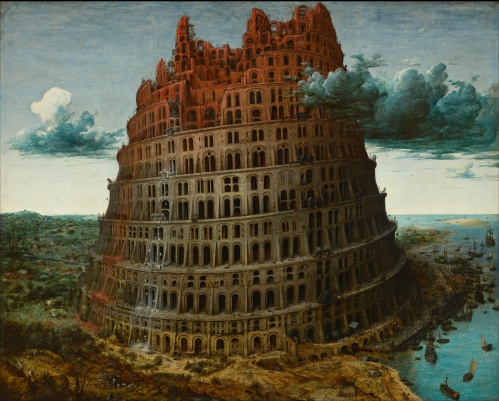Umberto Eco: Search for the Perfect Language

Pieter Brueghel the Elder (1526/1530-1569), The Tower of Babel (circa 1563-1565, oil on panel, Museum Bojimans Van Beuningen, Room 06, Rotterdam. Accession number 2443 (OK). Bequeathed to the Museum Bojimans Van Beuningen by Daniël George van Beuningen. Brueghel painted three versions of the Tower of Babel. This one is in the collection of the Museum Bojimans Van Beuningen in Rotterdam. A second version is in the collection of the Kunsthistorisches Museum in Vienna. A third version, a miniature on ivory, is apparently held by a private collector. Its disposition is unknown. The official position taken by the Wikimedia Foundation is that “faithful reproductions of two-dimensional public domain works of art are public domain”. https://commons.wikimedia.org/wiki/File:Pieter_Bruegel_the_Elder_-_The_Tower_of_Babel_(Rotterdam)_-_Google_Art_Project.jpg
This is the first page of my serialization of Umberto Eco, The Search for the Perfect Language, translated by James Fentress, Blackwell. Oxford, 1995.
Editorial Note
This book is not available in electronic formats from Amazon or other vendors, and there are no .pdf versions lurking anywhere on the web. The lone electronic version that I did uncover is hosted on OpenLibrary.org, and lending is controlled using Adobe Digital Editions. This so offended me that I digitized every page of the work. Making no apologies, I publish it here.
This book by Umberto Eco was mentioned in an article discussed earlier on this site, by Tzahi Weiss, “On the Matter of Language: The Creation of the World from Letters and Jacques Lacan’s Perception of Letters as Real,” 2009.
My post on this paper is published as Smoke Signals: Comments on Borges, Tzahi Weiss, Kabbalah, “On the Matter of Language: The Creation of the World From Letters and Jacques Lacan’s Perception of Letters As Real,” JJTP 17.1, Brill, 2009.
Eco Begins
With no further ado, Eco opens with several excerpts, one from Herodotus, History, II, I, another from Jonathan Swift, Gulliver’s Travels, III, pg. 5, and this one, from Leibniz, Letter to Duke of Hanover, 1679, which I excerpt in full.
“If only God would again inspire your Highness, the idea which had the goodness to determine that I be granted 1200 emus would become the idea of a perpetual revenue, and then I would be as happy as Raymond Lull, and perhaps with more reason . . . For my invention uses reason in its entirety and is, in addition, a judge of controversies, an interpreter of notions, a balance of probabilities, a compass which will guide us over the ocean of experiences, an inventory of things, a table of thoughts, a microscope for scrutinizing present things, a telescope for predicting distant things, a general calculus, an innocent magic, a non-chimerical cabal, a script which all will read in their own language; and even a language which one will be able to learn in a few weeks, and which will soon be accepted amidst the world. And which will lead the way for the true religion everywhere it goes.”
Leibnitz, Letter to Duke of Hanover, 1679.
“The dream of a perfect language did not only obsess European culture. The story of the confusion of tongues, and of the attempt to redeem its loss through the rediscovery or invention of a language common to all humanity, can be found in every culture (cf. Borst 1957-63). Nevertheless, this book will tell only one strand of that story — the European; and, thus, references to pre- or extra-European cultures will be sporadic and marginal.
This book has another limit as well; that is, a qualitative one. As I was on the verge of writing its final version, there reached my desk at least five recent projects, all of which seem to be related to the ancient prototypes I was dealing with.
I should emphasize that I will be limiting myself to those prototypes because Borst, whose own study concerns only the historical discussion on the confusion of tongues, has managed to present us with six volumes.
Finishing this introduction, I received Demonet’s account of the debate on the nature and origin of language between 1480 and 1580, which takes up seven hundred thick and weighty pages.
Couturat and Leau analyzed 19 models of a priori languages, and another 50 mixed or a posteriori languages; Monnerot-Dumaine reports on 360 projects for international languages; Knowlson lists 83 projects of universal languages during the seventeenth and eighteenth centuries; and, though limiting himself to projects in the nineteenth century, Porset provides a list of 173 titles.
Moreover, in the few years I have dedicated to this subject, I have discovered in antiquarian catalogues a large number of works missing from the biographies of the preceding books.
Some, by obscure authors, were entirely dedicated to the glottogonic problems; others were by authors known for other reasons, who, none the less, dedicated substantial chapters to the theme of the perfect language.
This ought to be enough to convince anyone that our list of titles is still far from complete; and, that therefore, to paraphrase a joke by Macedonio Fernandez, the number of things which are not in the bibliographies is so high that it would be impossible to to find room for one more missing item.
Hence my decision to proceed by a campaign of deliberated decimation. I have reserved attention for projects which seemed to me exemplary (whether for their virtues or their defects); as for the rest I defer to works dedicated to specific authors and periods.”
Umberto Eco, The Search for the Perfect Language, translated by James Fentress, Blackwell. Oxford, 1995, pp. 1-2.
